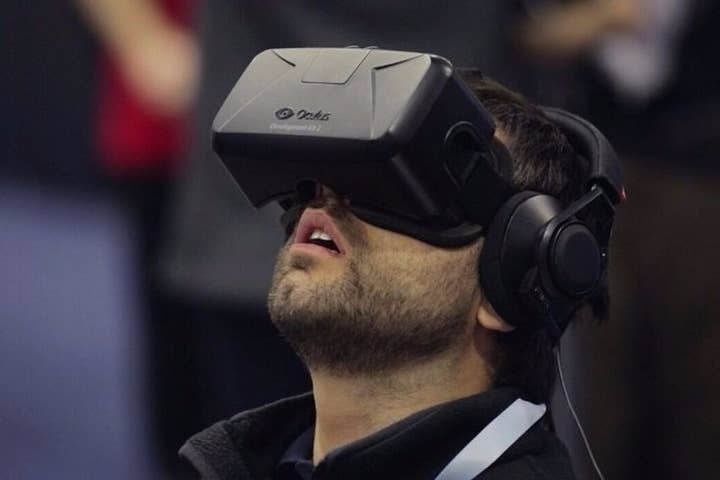"Our brains essentially are always screwing with us"
Radial Games' Dr. Kimberly Voll tells devs the weird ways our brains work, and how that can be used (or abused) in VR
For virtual reality to work at its best, there's a certain amount of deception involved. After all, the much-lauded sense of presence is essentially tricking a user into feeling like they are inhabiting virtual worlds, rather than hanging around in an ordinary room with a headset on. In her GDC talk Tuesday, Radial Games' research scientist and tech designer Dr. Kimberly Voll provided attendees with an overview of how the brain works in virtual reality, focusing on three key things to keep in mind.
First, as anyone familiar with the term "cognitive dissonance" knows, the brain will work pretty hard to create a consistent, sensible world view even in the face of conflicting evidence.
"It's going to try to make sense of this mess that is all this information coming in at any given time, even when it's inconsistent information," Voll said. "Your brain does not like being inconsistent. It will work very hard to straighten things out, which is great news if you're in VR, because this means most importantly the brain is working for us, and we can take advantage of this if we don't get in its way."
"We can actually trick the brain into seeing a lot of interesting things without those things actually being there, which turns out is also helpful in games, VR, and entertainment."
Second, our brains are not to be trusted. They present us their interpretation of reality, she said, and that can mean the brain rearranges memories, or convinces you completely that you saw something you never did.
"Our brains essentially, in short, are always screwing with us," Voll said. "And we need to be mindful of that because it affects how we see the projects we work on, how the consumers of our projects see them, and how we work with each other."
Finally the brain is, as Voll put it, "super gullible."
"We can actually trick the brain into seeing a lot of interesting things without those things actually being there, which turns out is also helpful in games, VR, and entertainment," Voll said.
Developers will need to consider all three things if they want to complete the illusion of virtual reality and achieve an enduring sense of presence in their games.
"You do not get presence for free in VR," Voll said. "It might seem that way because the first time you put on that display, your visual system is screaming at you, 'Holy shit, I'm in VR.' But once you get over that, and those of you who have worked in VR for a while will know what I'm talking about, other things will start to bubble up."
There's a wealth of different ingredients in the "perceptual soup" that Voll said adds up to presence, and some of it is simply beyond the ability of VR to replicate. Given that, it's important for developers to carefully consider the elements of their game that could take people out of the experience, or help bring them deeper into it. That could mean ensuring a consistent level of interactivity throughout the game (if a player can open one desk drawer, all desk drawers should be similarly interactive), or simply providing a narrative layer to dress up the gameplay and give players more reason to care about what they're being asked to do. But devs must be careful.
"While it might not be real, it's sure as heck real enough. And the potential for doing real psychological trauma is there."
"There is kind of, if you will, a dark side to this," Voll said. "Sometimes it's a funny dark side, but it's a dark side, where we can lead people to do things--without intending to--that they shouldn't be doing."
She gave an example from Fantastic Contraption, where players access the system menu by putting on a virtual helmet in the game world. The studio found that when players wanted to leave that menu, they often took the entire headset off in real life, rather than just the virtual headset. They've also had similar problems with players finishing VR demos and then laying the controllers down on a desk that only exists in the VR world. Worse still, some people try to lean on those virtual desks, with predictably jarring (and sometimes painful) results.
"We need to be careful of that because we're not going to ship ourselves with our products. But we have a responsibility about the affordances we're setting, at least to a certain extent," Voll said. "It's a collaborative responsibility, but I think we can't stick our heads in the sand."
She added, "Our players are putting their trust in us when they place themselves in the rig. Part of creating believable spaces is that we want people to believe in these spaces, and we want people to feel safe so that they can give into these spaces. If someone's uncomfortable, they won't let themselves go. And if we're contributing to that discomfort, well it becomes our fault."
Voll is not alone among developers calling for restraint in VR--particular with the use of jump scares--and she's also not alone in hearing push back to the idea. Many of those who object do so by downplaying the experience, reminding that it isn't actually real.
"While it might not be real, it's sure as heck real enough," Voll said. "And the potential for doing real psychological trauma is there. Physical trauma as well, people walking into walls, or scaring people to the point they have a heart attack. We don't know yet how this is going to go, but we have to be careful. We have to be mindful of this. Our players place their trust in us when they place themselves in the rig. If you take nothing away from this talk, take that away."

